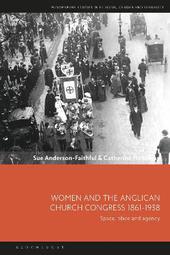
|
Women and the Anglican Church Congress 1861-1938: Space, Place and Agency
Hardback
Main Details
Description
This book covers new ground in its focus on the Anglican Church congresses 1861-1938 as a public space in which the views of notable women were widely disseminated. It celebrates the contribution made by women to public life and discourse on womanhood as platform speakers, and commemorates the presence of the large numbers of women who joined congresses as audience members. Original research draws on extensive primary sources from official records, diaries and the press to capture women's views and voices and to evoke congress as a communicative social space and a window into topical affairs. Women and the Anglican Church Congress 1861-1938 examines the roles of women in the Church and reflects on how women with a sense of vocation negotiated contemporary attitudes to their positions and spirituality. The book also explores how women's secular aspirations towards citizenship in the context of poverty, work, temperance, eugenics, class and suffrage played out at congress.
Author Biography
Sue Anderson-Faithful is Senior Lecturer in Education and Convenor of the Centre for the History of Women's Education at the University of Winchester, UK. Catherine Holloway is Lecturer in Education and Childhood Studies at the University of Winchester, UK.
ReviewsDiverse themes such as philanthropy, politics, service, empire, place and space are used to examine women's agency and activism within the Church of England congresses. Meticulously researched, this is a deeply engaging book that offers an insightful analysis of women's lives, identities and experiences. * Tanya Fitzgerald, Professor of Higher Education, The University of Western Australia, Australia * The history of the Church of England has tended to be told as one shaped by the machinations of its male clergy and hierarchy alone. This book breaks new ground in giving prominence to the agency of the many lay women who served the church, directing and influencing its future shape through the newly created Church Congress, from 1861 onwards. This book presents a detailed and important account of an otherwise neglected aspect of ecclesiastical history. * Stephen G. Parker, Professor of the History of Religion and Education, University of Worcester, UK *
|